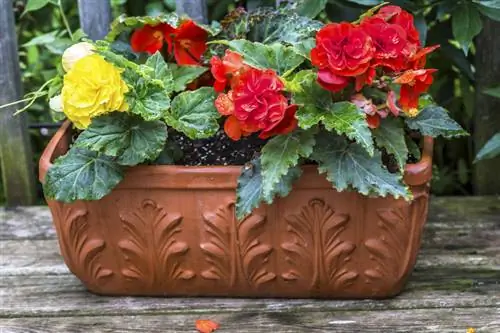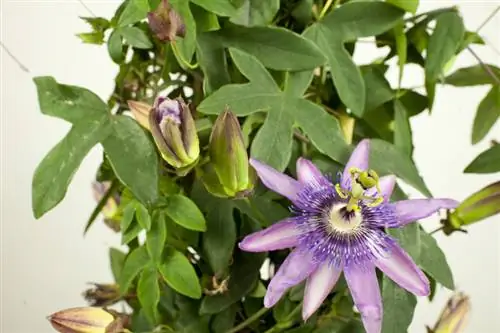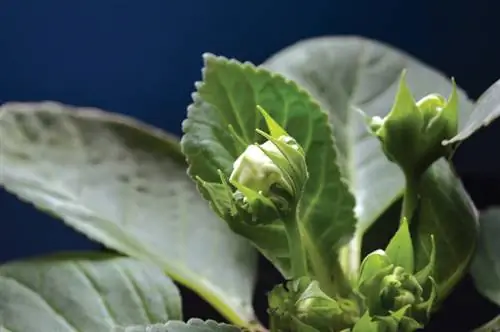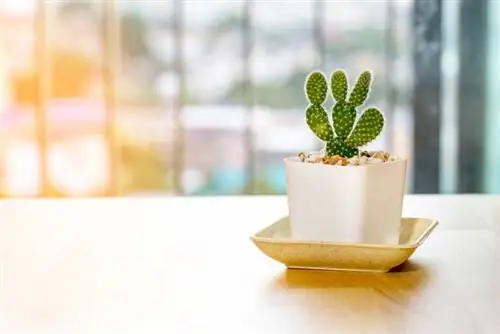- Author admin [email protected].
- Public 2023-12-16 16:46.
- Last modified 2025-01-23 11:19.
Do you know begonias as pure houseplants or summer varieties that grow outdoors? Whether in a pot or in a bed: Begonias are shade plants that are sensitive to frost. If you want to overwinter begonias, you should know and consider the various options.

How can you properly overwinter begonias?
In order to overwinter begonias successfully, indoor begonias should be placed in a bright room with a plant light and watered and fertilized less. Outdoor begonias must be dug up before frost, pruned and stored in frost-free rooms. In both cases, the plants should be kept dry during the winter break.
Indoor begonias overwinter with easy care
The rule of thumb for wintering is: the warmer the room, the brighter it should be. If there is too little light, the leaves will fall off. Because begonia plants release more CO 2 than they absorb through photosynthesis. In rooms that are too warm, plant lights (€79.00 on Amazon) prevent leaf loss during the winter.
But even in cool rooms with too much light, begonias react by dropping their leaves. Light increases the temperature on the leaf surface and activates photosynthesis. However, since fewer nutrients are transported due to the low room temperature, the plant reduces its foliage. A cold-insulating or heated mat in the root area solves the problem.
Regardless of whether it is a warm or cool room: overwintering means a vegetative rest period for begonias with a significantly lower need for water and nutrients. The following applies here: less is more. And only water enough so that the root ball doesn't dry out completely.
Outdoor begonias overwinter safely
Begonias are not hardy. Therefore, dig up in good time before the thermometer falls below 0°C. Shorten existing leaves to two centimeters and leave to rest in dry, loose planting substrate or wrapped in newspaper. The optimal winter location for begonia tubers is a frost-free room. Temperatures around 10°C are ideal.
It is recommended to overwinter indoor and outdoor begonias.
- Air rooms regularly
- Avoid direct sunlight
- do not fertilize
- moisten something
Keep dry during the winter rest period otherwise the root tubers will rot! If you remove the soil completely, you have to make sure that the tubers don't dry out! Because they have no protective scale leaves. Therefore, moisten the tubers slightly from time to time.
Are there hardy begonias?
These two begonia varieties are considered relatively winter-hardy.
- Begonia grandis ssp evansiana
- Begonia sinensis ssp evansiana
But still be careful. These supposedly frost-resistant begonias also need additional protection from the cold, such as a layer of brushwood.
Begonia care after the winter period
First begonia care steps from the end of February to the beginning of March: Insert the open begonia bulb into the substrate and water. Place the begonias back in a warmer and brighter place in the house.
If the first green leaves sprout, you can start fertilizing again. But only put the begonias back outdoors after the Ice Saints.
Begonias bloom profusely and especially in shady locations where hardly any plants otherwise thrive. That's why they're worth saving over the winter.
Tips & Tricks
If you want to save space when overwintering begonia plants, or if you know you are watering too much, you should remove the tubers from the soil. Make sure that you do not overwinter your outdoor begonias too warmly. Otherwise they will sprout too early and become horny.






